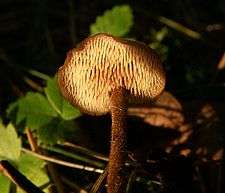Auriscalpium
| Auriscalpium | |
|---|---|
 | |
| Auriscalpium vulgare | |
| Scientific classification | |
| Kingdom: | Fungi |
| Division: | Basidiomycota |
| Class: | Agaricomycetes |
| Order: | Russulales |
| Family: | Auriscalpiaceae |
| Genus: | Auriscalpium Gray (1821) |
| Type species | |
| Auriscalpium vulgare Gray | |
| Species | |
|
A. andinum | |
| Synonyms[1] | |
Auriscalpium is a genus of mushrooms typifying the family Auriscalpiaceae[2] and characterized by in part by rough-walled, amyloid spores that are produced on pendant spines, hence it is considered to be a tooth fungus. The type species, A. vulgare, is a common, easily identified fungus in the Northern Hemisphere found fruiting exclusively on mature, fallen, often buried conifer cones. Its wiry, long hairy stipe is topped by an eccentrically placed, shaggy pileus bearing the pendant, flexible, spore-bearing spines. The entire fructification resembles and perhaps could be used as an ear pick (see etymology below). Other species in the genus do not occur on cones or lack the eccentric pileus on a long stalk. According to the Dictionary of the Fungi (10th edition, 2008), the genus contains eight widely distributed species.[3]
Etymology
Auriscalpium is a compound of the Latin, auris, "ear"; and scalpo, "I scratch", generally meaning ear pick. The term was originally applied as a specific epithet by Linnaeus in 1753, viz. Hydnum auriscalpium and changed in 1821 to vulgare when S.F. Gray recognized the cone-inhabiting fungus as a new genus, named after its type species, Auriscalpium vulgare. Tautonyms, such as "Auriscalpium auriscalpium" are illegitimate under the International Code of Botanical Nomenclature.
References
- ↑ "Auriscalpium Gray 1821". MycoBank. International Mycological Association. Retrieved 2010-11-01.
- ↑ Miller, S.L.; et al. (2006). "Perspectives in the new Russulales". Mycologia. 98 (6): 960–970. PMID 17486972. doi:10.3852/mycologia.98.6.960.
- ↑ Kirk PM, Cannon PF, Minter DW, Stalpers JA (2008). Dictionary of the Fungi (10th ed.). Wallingford: CABI. p. 69. ISBN 978-0-85199-826-8.